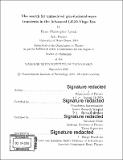| dc.contributor.advisor | Erotokritos Katsavounidis and Salvatore Vitale. | |
| dc.contributor.author | Lynch, Ryan Christopher. | en_US |
| dc.contributor.other | Massachusetts Institute of Technology. Department of Physics. | en_US |
| dc.date.accessioned | 2021-10-06T19:57:01Z | |
| dc.date.available | 2021-10-06T19:57:01Z | |
| dc.date.copyright | 2018 | en_US |
| dc.date.issued | 2018 | en_US |
| dc.identifier.uri | https://hdl.handle.net/1721.1/132742 | |
| dc.description | Thesis: Ph. D., Massachusetts Institute of Technology, Department of Physics, September, 2018 | en_US |
| dc.description | Cataloged from the PDF version of thesis. | en_US |
| dc.description | Includes bibliographical references (pages 227-238). | en_US |
| dc.description.abstract | Between 2015 and 2017, the era of gravitational-wave (GW) astronomy began in a spectacular fashion. The Advanced-era GW detectors directly observed GW transients from two types of compact-binary sources: binary black holes (e.g., GW150914) and binary neutron stars (e.g., GW170817). Compact-binary sources are well-studied theoretically with well-understood strain waverforms, and thus their detections with Advanced LIGO-Virgo has led to an enormous number of physical insights. Nevertheless, we expect transient GW sources with waveforms that are not fully modeled or are too quiet to be fully resolved may contain an abundant wealth of physical richness in their own right. This thesis explores how to confidently establish poorly-modeled and poorly-resolved, i.e., "unmodeled", GW transients as detections. We first develop a search algorithm that can be used to detect short-duration GW transients of general signal morphology. This algorithm was one of two independent algorithms to first detect the first GW detection, GW150914, in low-latency. After establishing how GW transients of arbitrary morphology can be detected, we turn our attention to the detection of quiet GW signals that are not fully resolvable. We first explore the prospect of using multi-messenger astronomy to elevate low-significance GW candidates to the status of confident detections. Then, we develop a statistical consistency test that can be used to detect populations of poorly-resolved GW candidates. We apply the new search algorithm and new statistical consistency test to data obtained in the first and second observing runs of the Advanced Detector Era. We show that standard compact-binary sources, such as GW150914, can be detected confidently using these methods. Although no non-compact-binary GW transients are detected, we use these new tools to set the strictest upper limits to date on the rate-density of non-compact-binary GW transients. Finally, we turn our attention to how future improvements to the Advanced Detectors, such as squeezed-light injection, will impact the science done with GW transients. | en_US |
| dc.description.statementofresponsibility | by Ryan Christopher Lynch. | en_US |
| dc.format.extent | 238 pages | en_US |
| dc.language.iso | eng | en_US |
| dc.publisher | Massachusetts Institute of Technology | en_US |
| dc.rights | MIT theses may be protected by copyright. Please reuse MIT thesis content according to the MIT Libraries Permissions Policy, which is available through the URL provided. | en_US |
| dc.rights.uri | http://dspace.mit.edu/handle/1721.1/7582 | en_US |
| dc.subject | Physics. | en_US |
| dc.title | The search for unmodeled gravitational-wave transients in the Advanced LIGO-Virgo Era | en_US |
| dc.type | Thesis | en_US |
| dc.description.degree | Ph. D. | en_US |
| dc.contributor.department | Massachusetts Institute of Technology. Department of Physics | en_US |
| dc.identifier.oclc | 1263579890 | en_US |
| dc.description.collection | Ph.D. Massachusetts Institute of Technology, Department of Physics | en_US |
| dspace.imported | 2021-10-06T19:57:01Z | en_US |
| mit.thesis.degree | Doctoral | en_US |
| mit.thesis.department | Phys | en_US |
